BY STEVE POND
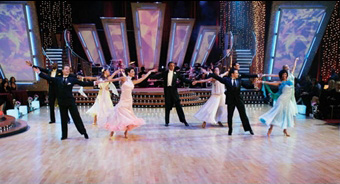
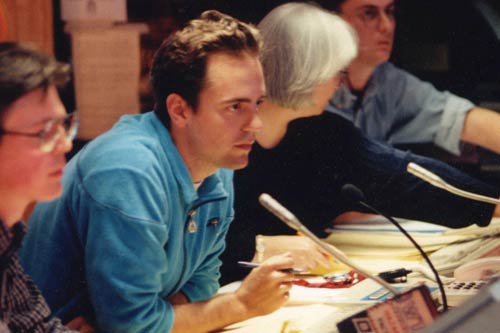 DANCING WITH THE STARS: It's a good old-fasioned musical variety,"
DANCING WITH THE STARS: It's a good old-fasioned musical variety,"
says director Alex Rudzinski. (Credit: Adam Larkey/ABC, Inc.)
In a control room adjacent to Stage 36 at CBS Television City in Los Angeles, Michael Simon sits in front of a wall of screens, eyeing 60 television monitors and preparing to shoot an episode of Rock Star: Supernova, the rock 'n' roll variety show that concluded its second season this fall. With 10 minutes until the taping begins, he looks around the room. "All right," he says to his team. "Let's have a good one everybody, shall we?"
Rock Star features contestants battling it out for the chance to front a band of legendary rockers. Over the last two days, Simon has watched rehearsals and planned the moves of the thirteen cameras he'll use to shoot eight different performances, knowing full well that a few of the contestants will probably do things they didn't do during rehearsal. In the last half hour he's gone over script changes with his ADs. He's dealt with the placement of bongo drums on the stage (a contestant wants them in one position, Simon prefers somewhere else). He's tried to figure out if another contestant will be performing her song in English or Spanish, since she's done it both ways during rehearsals. He's asked stage managers to move the audience because a new fire marshal has restricted capacity to less than previous tapings. And he's conferred briefly with producer Mark Burnett, who strides into the control room in a pinstriped suit with a head full of ideas beneath a modest pompadour.
Now, Simon looks at the monitor directly in front of his chair. On the screen, host Brooke Burke has just taken her position on the stage to resounding applause from the audience gathered in the soundstage; she's followed by guitarist Dave Navarro, then by the three band members (drummer Tommy Lee, guitarist Gilby Clarke and bassist Jason Newsted) who've been assembled for the purpose of recruiting a lead singer via this summer series.
As the band members take their seats in a series of carved, ornate chairs, the crowd erupts into applause and whoops of approval. In the control room, Simon turns to associate director Kathy Fortine and laughs. "Don't you feel like when we take our positions, we should be applauded?" he asks.
Fortine laughs and shakes her head, but Simon's got a point. At a time when performance-based reality shows have taken over a huge amount of prime-time airspace; when far more people watch amateurs compete on American Idol than pros compete for Grammys; when TV schedules are replete with people dancing with the stars and skating with celebrities and vying to be the last comic standing and attempting to prove that America's got talent; when a cranky Brit named Simon Cowell has turned into a star and a 54-year-old David Hasselhoff has engineered an unlikely comeback—given all that, shouldn't a few cheers be directed toward the folks responsible for putting all that singing and dancing and skating and juggling talent on camera?
Perhaps, but in the absence of a round of applause from the studio audiences they assiduously document, these directors will settle for the satisfaction of pulling off the tricky assignment of entertaining America with a batch of amateurs who aren't used to hitting their marks or playing to the camera—performers, in other words, who may or may not be ready for prime time.
"The uncertainty is part of the turf on a show like this," says Simon, a veteran of filmed concerts, awards shows and Jimmy Kimmel Live. "And I have to say, I've had as much fun shooting this series as anything I've ever done."
Just don't use that word reality. Alex Rudzinski, who directs Dancing With the Stars, doesn't think it's accurate. "I am not fond of the 'reality' label slapped across most new entertainment shows," he says. "Stars is good old-fashioned musical variety." Bruce Gowers agrees, and he ought to know by virtue of his five seasons helming American Idol, the phenomenon that launched many other performance-based shows.
But not all the shows are created equal, and so the shows directed by the likes of Gowers and Simon come together in a lot of different formats and approaches. Rock Star tapes in a mostly live run-through two days before it airs, but Simon says he overshoots purposely to allow more options in editing; between the taping and the airdate, the judges' comments are shortened considerably, (occasionally pre-taped) reaction shots are inserted, and more attention is paid to the judges and other contestants during each performance.
"The show is really about the drama of the people in it, so I try to do a thorough job of covering the people watching the songs," he says. For Simon, that means shooting the performances the way he would any concert sequence, cutting on the beat and keeping the camera in motion, but also making sure that he catches the little things that remind viewers they're watching a high-stakes competition: the judges who turn to each other and laugh (they're mocking this poor guy, the home viewer thinks), the fellow contestant who watches impassively, then raises one eyebrow (I bet those two hate each other). "The idea is to keep the excitement of a live performance," says Simon, "but make the drama a little more potent."
Shows like America's Got Talent (directed by Russell Norman), Last Comic Standing (directed by Chuck Vinson) and So You Think You Can Dance (directed by Nigel Lythgoe) similarly tape a couple of days before their airdates, time for a quick polish. But Dancing With the Stars, says Rudzinski, is shot live, despite the intricacy of the dance routines performed by professional dancers paired with untrained celebrities.
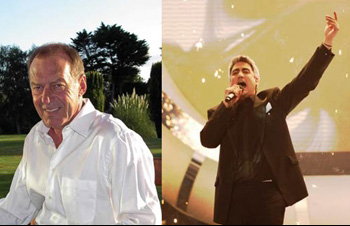 AMERICAN IDOL: "I didn't think it would be a success," says Bruce Gowers
AMERICAN IDOL: "I didn't think it would be a success," says Bruce Gowers
who has directed the show for all five seasons. (Credit: Ray Mickshaw/FOX)
"It's very much live, and thus the cause of my ever-graying hair," says British-born Rudzinski, who watches video of rehearsals and then lays out every move for maximum impact. "In essence, I storyboard every shot on every performance," he says. "I might have forty or fifty shots for a two-minute performance that I've choreographed in my head to match the dancer's moves. But working this intricately is the only way of guaranteeing quick and accurate shots—maybe just picking off a dancer's glance in close-up for one beat."
Those little beats, he adds, are crucial. "I'll always try to show off key moves from the most favorable angle, but my job is a constant challenge to balance portraying the emotions and the celebrity's facial expressions without losing any of the crucial choreography. If this wasn't an entertainment show, I would stay permanently framed head-to-toe on a couple. But the expressions and physical exertion shown in celebrity close-ups adds so much more to the story."
On American Idol, which goes out live to the East Coast, Gowers goes for the emotionally charged close-ups but deliberately downplays the reaction shots that are so prominent on shows like Rock Star. "Some people like to cut away to the judges in the middle of a performance, which I personally hate," says the director, a British-born 36-year veteran of awards shows and music programs. "As a viewer, I want to see the performance, I don't want to see the judges laughing or talking."
Which is not to say that he shies away from reaction shots at other times—for instance, when Simon Cowell and his fellow judges are critiquing a performance, or when contestants are eliminated during Idol's weekly results show. "There's a lot of emotion, especially during the judging," he says, and then grins. "And I go for every scrap of emotion I can get—if there's a tear in somebody's eye, I'm there with a close-up."
And if Gowers doesn't see something, one of his crew is likely to catch it. "Bruce can't see everything out on the floor, so we all work as his eyes and ears at certain times," says stage manager Debbie Williams, who has worked every season of Idol, along with America's Got Talent, So You Think You Can Dance, Rock Star: INXS, Dancing With the Stars and others. "We'll watch what's going on, and if I tell him that Paris is crying, boom, he's got a camera on Paris crying."
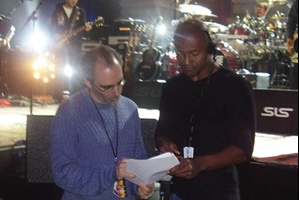 ROCK STAR: SUPER-NOVA: "The uncertainty is part of the turf on
ROCK STAR: SUPER-NOVA: "The uncertainty is part of the turf on
a show like this," says Michael Simon. (Credit: Robert Voets/CBS)
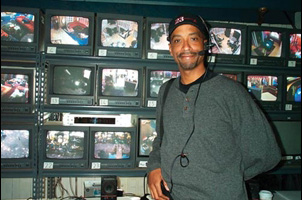
LAST COMIC STANDING: "Head-to-toe to a close-up is the way comedy
usually works on TV," says Chuck Vinson. (Credit: Chris Haston/NBC)
Whether their shows are live or edited, directors of the performance-based reality shows all face similar challenges—particularly adjusting to performers whose professional experience is for the most part limited. "They totally do things that I'm not expecting," says Gowers of Idol's contingent of young aspirants. "I might expect them to go to center stage on the chorus, but instead they'll cross and come into the audience. But I've got a great crew and everybody knows what could happen, so we just go with the flow.
Rudzinski agrees that the unexpected is almost inevitable. "A handheld camera might not make its next position, my Steadicam might end up slightly off mark, and very often the couple's routine gets slightly out of sync with the orchestra," he says. "My scripted close-up, being only a beat long, now only shows the back of someone's head. But at the end of the day we get it 99 percent right, and that's pretty good."
Chuck Vinson, who directed a number of television series, music programs and stand-up comedy specials before taking on Last Comic Standing, says he prepares similarly for that stand-up comedy competition, studying rehearsals to learn each comic's timing. "Head-to-toe to a close-up is the way comedy usually works on TV," he says. "But I need to get their timing down, because you've got to know when a punch line is coming. If you're on a wide shot instead of a close-up when somebody delivers a punch line, it really dilutes the impact of the joke."
And diluting a joke, he says, can have dire consequences. "America is voting for these people, so I have to show them all equally. If I do a better job of capturing one comic, or if I miss on somebody else, it could affect their votes. That's why I always try to find people in the audience who are really laughing, and cut to them. If you cut to somebody in the audience and he's just sitting there, it could make the voter at home think, 'I guess this guy's just not that funny.'"
Each season, Last Comic Standing presents one completely live show: the finale, in which winners from the previous seasons deliver short sets, and then the two finalists take one more turn before the winner is revealed.
"It's such an adrenaline rush, and I would love to go live all the time," says Vinson. "But it's nerve-wracking. On this year's finale, a couple of the earlier guys went overtime, and then [one-time LCS host] Jay Mohr did six minutes, and we started to freak out. We can't run long. We asked Ty [Barnett] to please cut his set short, but Ty went 40 seconds long. So we got to the commercial break before [eventual winner] Josh [Blue], and we pleaded with him. He was supposed to do five minutes, and we said, 'We're running long, we need you to do three minutes and fifty seconds.' He said no problem, and he nailed it."
Finales are particularly tricky—American Idol, for one, seldom has the time to even rehearse its extravagant final episodes all the way through. "A lot of the time, Bruce is completely winging it," says Debbie Williams. Michael Simon thinks back to a finale of a different sort, when he directed the finale of Burnett's boxing series The Contender, which ended with a sanctioned boxing match with a million-dollar prize.
"It was completely insane," he says. "I hadn't worked in sports since 1984, there hadn't been boxing on prime-time network TV in decades, and the matches up to then in the series had been shot using a very stylized look, with slow motion and things I couldn't use." Adds Simon's AD, Kathy Fortine, "We had so many different scenarios for that finale, because the fight could have lasted seven rounds or it could have lasted thirty seconds. We had to be prepared for everything."
In a field where preparation is paramount—along with the ability to improvise when things don't go the way you planned—there's one thing that all the directors say they were not prepared for: the popularity of the shows they're working on. "When I did the American Idol pilot, I didn't think it would be a success," says Gowers. "I'd seen the English show, and I knew the setting changed throughout the series, from auditions to a small set to a grand set, and I thought, the American audience will never latch onto something that is constantly moving and altering."
He laughs. "So I was surprised by the appeal it had. But I think the audience likes the fact that they are actually part of the show, that they can vote and have some kind of control. And also, it appeals to little kids who want to be that idol."
Alex Rudzinski sees it in simpler terms: to him, the shows are successful because viewers get caught up in the stories the directors are telling. "This format is successful because it evokes an emotional response from viewers," he says. "Ultimately, it's the narrative we create on screen that enables our audience to care about the performers they see."